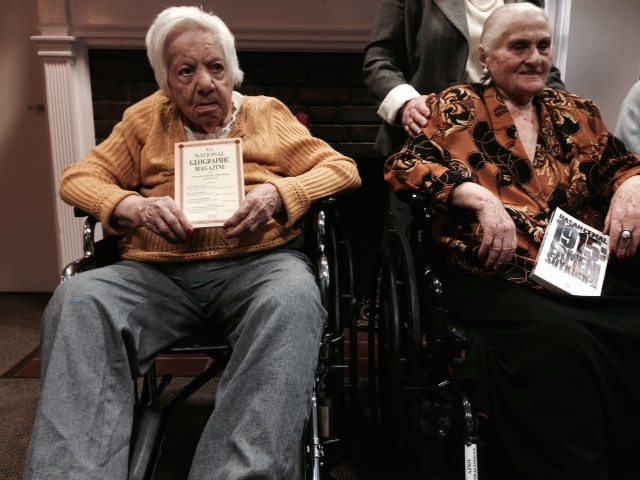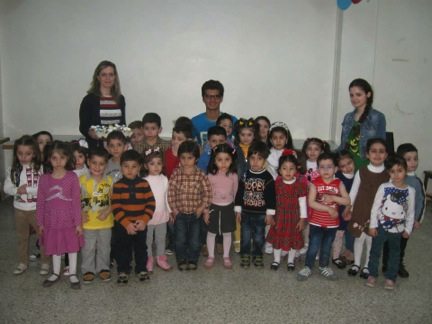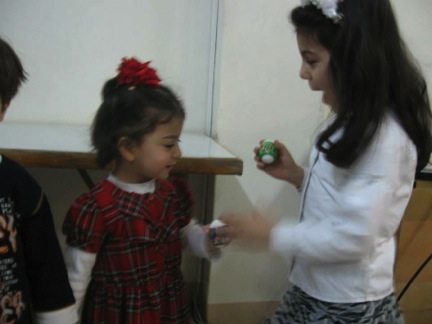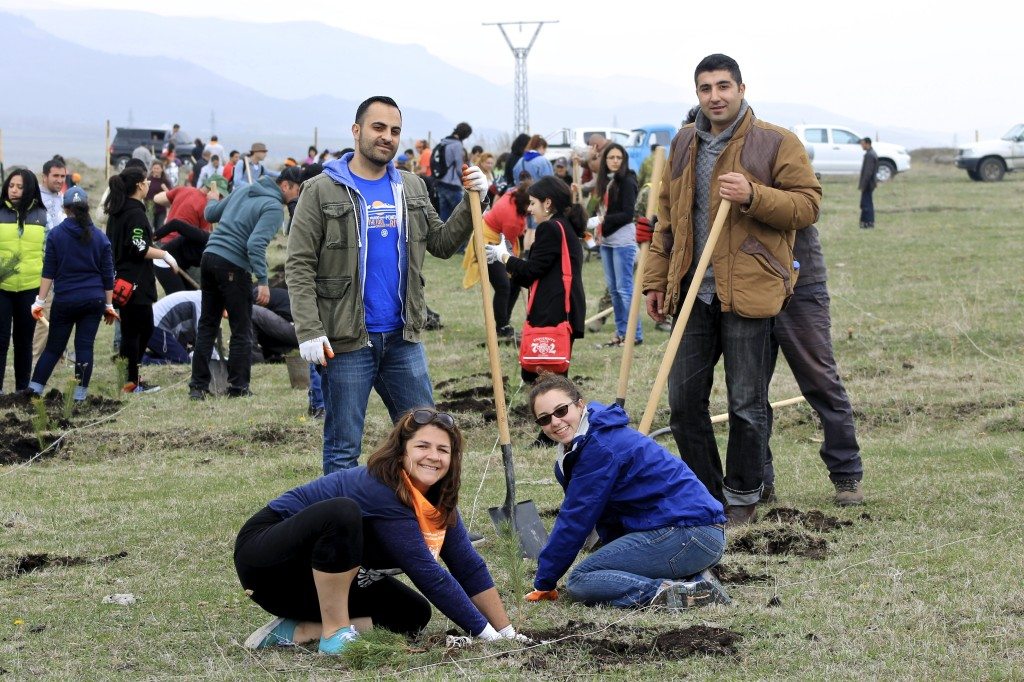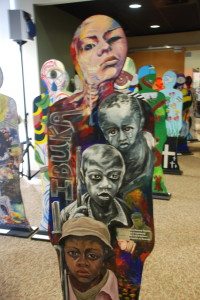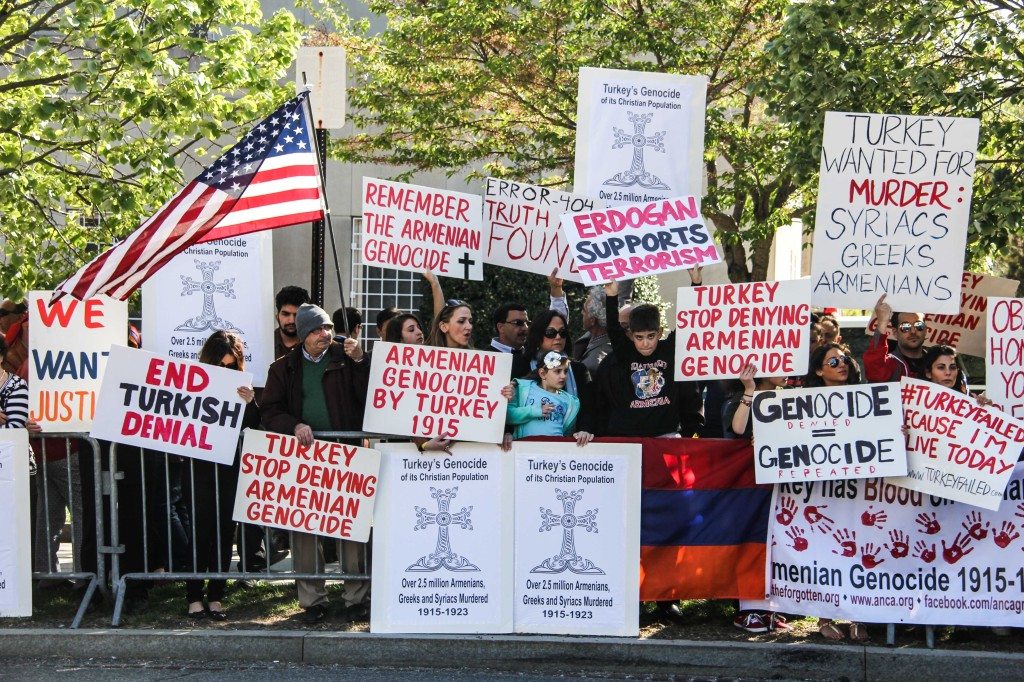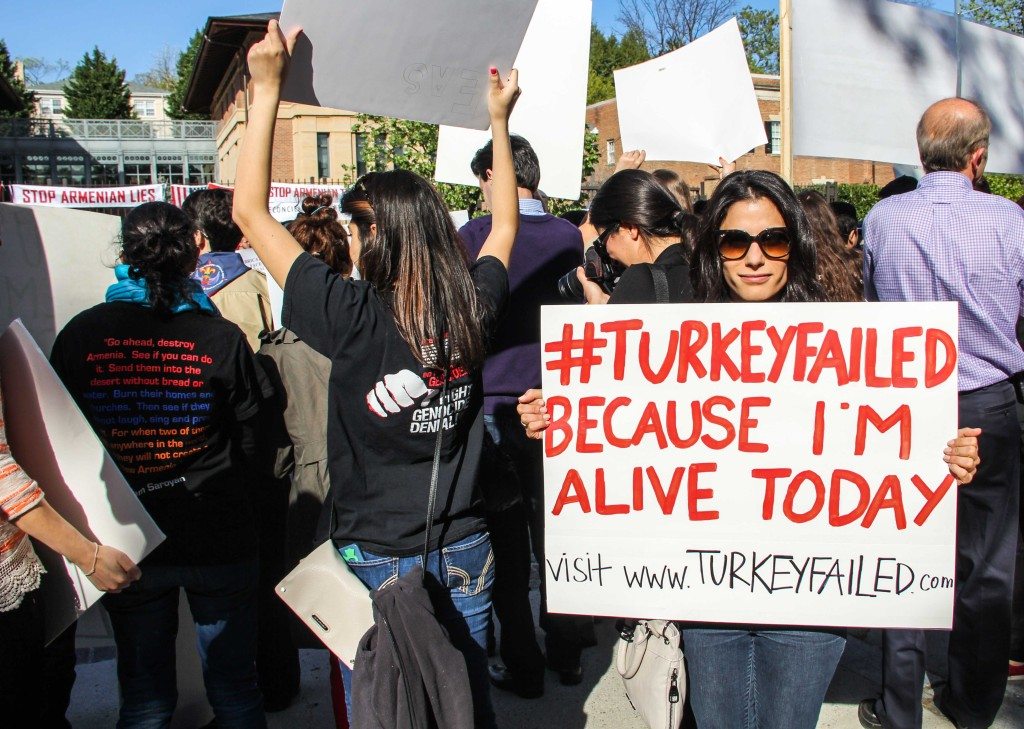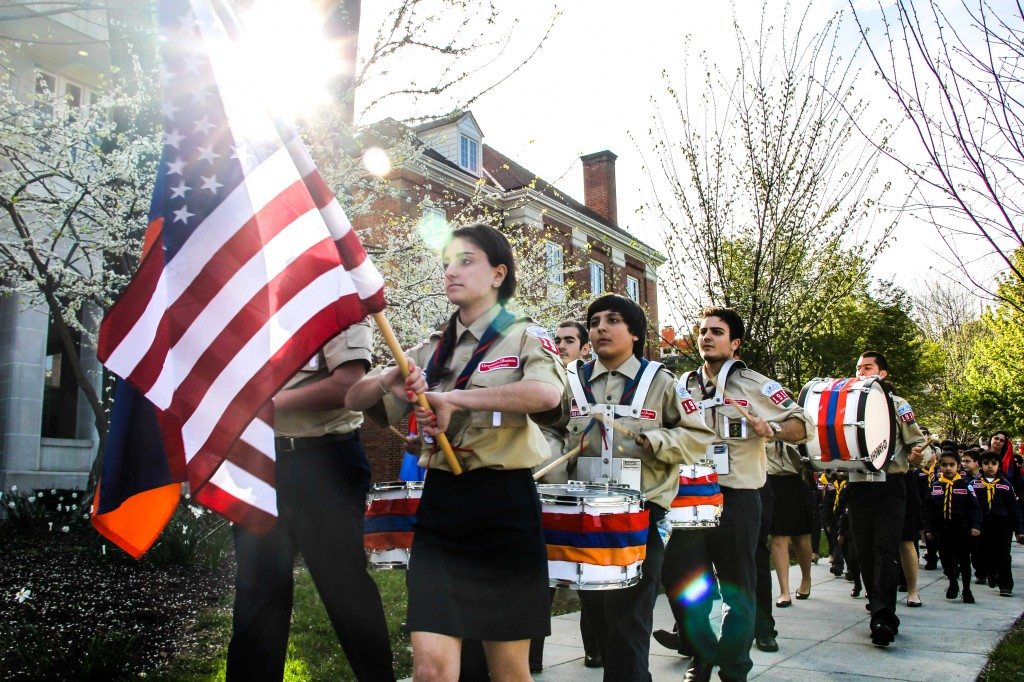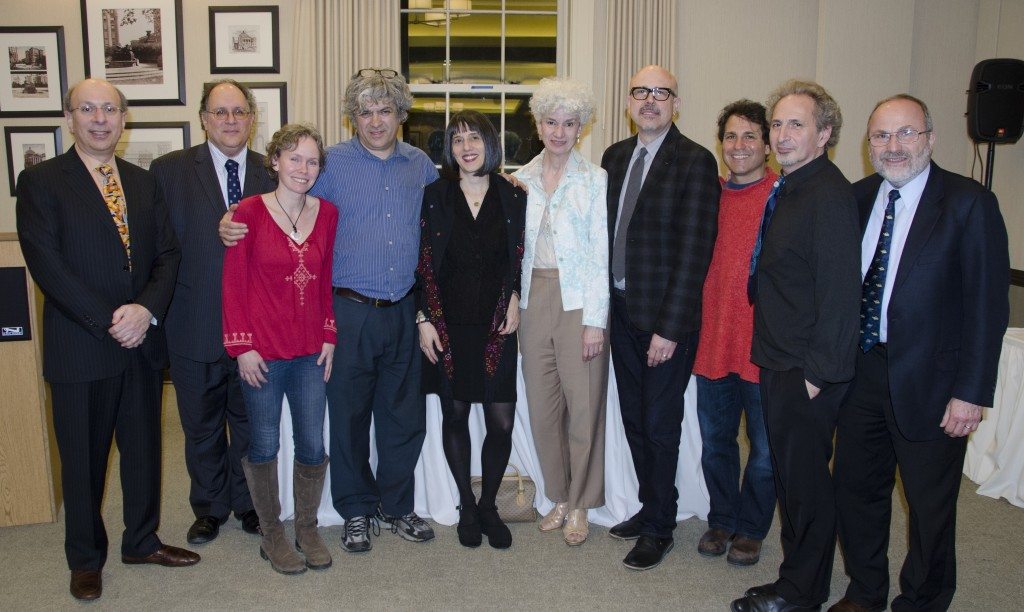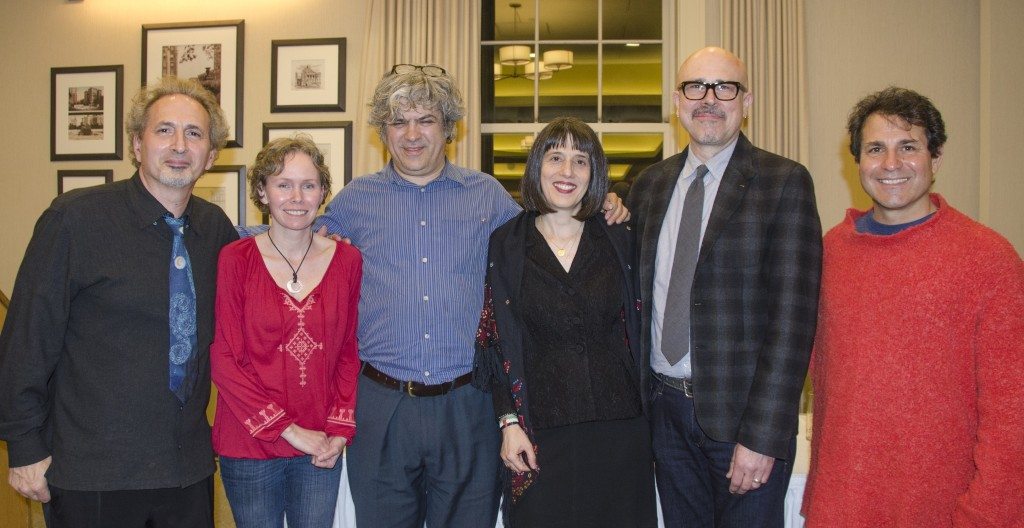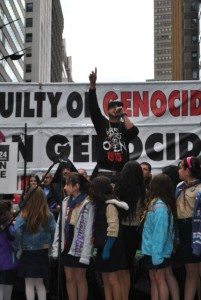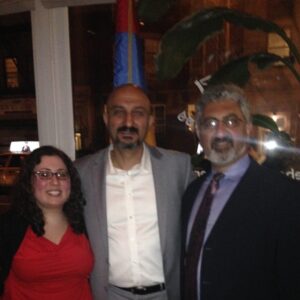![A scene from the commemoration]()
A scene from the commemoration
99th Commemoration Brings Thousands to Times Square
From the proclamations of staunch support by high-ranking U.S. politicians to the touching lyrics of a talented Armenian-American rapper’s tribute to the millions of lives lost, the 99th commemoration of the Armenian Genocide in Times Square paid homage to the victims of 1915 and sent a resounding message that denial will not be tolerated as the Centennial memorial approaches.
![An impressive crowd gathered at this year’s commemoration.]()
An impressive crowd gathered at this year’s commemoration.
An impressive crowd gathered at this year’s commemoration, an all-encompassing event organized by the Knights of Vartan for the past quarter of a century in one of the world’s most visible and attractive locations. While the missing survivors in the audience were a stark reminder that witnesses are succumbing to history, this year’s sizeable group of Armenian youth, from the disciplined Homenetmen Scouts who proudly held the Armenian flag throughout the duration of the program, to the members of the Areni Choir and the Higher Brass Band, to those draped in Armenian flags, an emphatic statement was made that the 1.5 million victims will not be forgotten and that the fight for genocide recognition will continue through new blood.
Appearing faithfully year after year, key U.S. politicians took to the stage once again to reaffirm their commitment to the Armenian cause and did not fail the community in expressing their firm support of genocide recognition, most recently in the U.S. Senate Foreign Relations Committee, which this month passed Resolution 410, demanding that Turkey acknowledge the Armenian massacres in 1915 as “genocide.”
Chairman of the committee, Senator Robert Menendez (D-N.J.), said the resolution was passed in “undisputed terms,” and described the Armenian Genocide as “one of the darkest events in human history.”
“We must not make it the policy of the United States to turn our back on man’s inhumanity to man,” said Menendez. “And anyone who tries to create a nuanced approach serves only to empower those around the world who would use genocide as a weapon of war.”
Commending the Armenians for building a strong community in America, Senator Chuck Schumer (D-N.Y.) recalled the founder of the Armenian Genocide Times Square commemoration, Sam Azadian, who introduced him to the history of the Armenian Genocide when he was a newly elected assemblyman.
![The program culminated in an emotional performance by R-Mean]()
The program culminated in an emotional performance by R-Mean
“I come here because I believe from the bottom of my heart it is our sacred duty to speak out against the terrors of the past,” said Schumer. “Remembering the innocent victims of the ‘Medz Yeghern’ helps as we strive to shine the full light of day on this historic tragedy to ensure it never happens again.”
Congressman Frank Pallone, Jr. (D-N.J.) praised the Armenians on their relentless efforts towards Armenian Genocide recognition and noted the movement’s success worldwide and in Turkey, where scholars and human rights advocates are opening sincere dialogue about the Armenian Genocide. He spoke of continued commitment not only towards genocide recognition, but humanitarian aid to the Republic of Armenia and Nagorno-Karabagh as well.
“Continue to do all of your hard work,” said Pallone. “Even though it’s the 99th year, we will not stop until we see genocide recognition.”
Following in his father’s (former Councilman Peter Vallone) footsteps, Paul Vallone (D-N.Y.) said that like his father, he was proud to support the commemoration in Times Square every year. Vallone greeted the crowd in Armenian and asserted his commitment to working with Albany and Congress to make sure the Armenian Genocide is recognized.
“Armenia is our family,” said Vallone. “It’s our faith, our culture, our language, and as we stand here in the middle of the greatest city of the world, we see that the Armenian Genocide has not been forgotten.”
Traveling straight from Armenia where he attended Armenian Genocide commemorations there, Congressman Eliot Engel (D-N.Y.) said that Turkey needs to publicly accept the atrocities without the use of convoluted statements. “A genocide is a genocide and the sooner Turkey recognizes and apologizes for it, the better off everyone will be.”
Congresswoman Carolyn Maloney (D-N.Y.) also expressed her efforts in Congress for U.S. recognition of the genocide and the importance of stating it by its factual name. “Genocide is genocide is genocide,” said Maloney. “Ninety-nine years is enough. We must join the world community in recognizing the genocide and the atrocious actions of Turkey.”
Remarking that it is the “responsibility” of the U.S. to recognize the Armenian Genocide, former New York City Comptroller, John Liu, said to continue the fight until an apology is achieved. “Whether it has been 100 or 200 years, this gathering will continue to take place because we know the truth and the rest of the world has to do so as well.”
“We have been here for a quarter of a century,” said Dr. Dennis Papazian, Professor Emeritus of History at the University of Michigan and Past Grand Commander of Knights of Vartan, as he looked out onto the substantial crowd in front of him in Times Square. “And we will come back for another quarter of a century until justice is done for the Armenian people.”
Also in his remarks, Papazian provided a response to the unprecedented statement of Turkish Prime Minister Recep Tayyip Erdogan, issued on April 23, in nine languages, in which the politician encouraged Turks and Armenians to talk to one another about the past and once again ignored the truth of the Armenian Genocide. Papazian, who has worked towards genocide recognition for decades, said he remains hopeful.
“I have witnessed a change in Turkish society where people can discuss the Armenian Genocide without being thrown in jail,” he said. “Honest Turkish scholars are now organizing conferences to shed light on the truth.”
Papazian also commented on President Barack Obama’s April 24 message, which he considered his “strongest statement” yet, despite the fact that the president continues to insist on referring to the Armenian Genocide as “Medz Yeghern.”
“Our efforts haven’t been in vain,” asserted Papazian. “We are winning the battle and we shall persist until our martyrs are properly recognized.”
The program culminated in an emotional performance by R-Mean that brought all of Times Square to its feet as members of the audience, as well as passersby, waved peace signs in the air to the lyrics of his song, “Open Wounds.” Hailing from Los Angeles, the young Armenian-American rapper has been an active supporter of genocide recognition and spreading awareness outside of the Armenian community, in particular with reputable individuals in the music and entertainment industry. He hopes to educate the masses through hip-hop music, which he considers to be the “voice of the oppressed, the voice of the struggle, and the voice of the youth.”
“The goal of the song ‘Open Wounds’ and the ‘Open Wounds 1915 Movement’ is to raise awareness for the youth who are our future and the non-Armenians who enjoy listening to good music with a positive message,” said R-Mean. “In a sense, this is doing the exact opposite of what the Turkish government has been trying to do all these years by erasing it from the history books.”
Archbishop Oshagan Choloyan, Prelate of Armenian Church of America (Eastern), gave the invocation and Archbishop Khajag Barsamian, Primate of the Diocese of the Armenian Church of America (Eastern), delivered the benediction. Other clergy in attendance included Very Reverend Thomas Garabedian of the Armenian Catholic Eparchy of the United States and Canada and Reverend Haig Kherlopian of the Armenian Evangelical Church of New York.
Susan Rosenblatt from the Jewish Press delivered remarks, as well as Lisa Kradjian, Grand Matron of the Daughters of Vartan. Delivering remarks on behalf of the co-sponsors of the commemoration were Kim Yacoubian (AGBU), Alex Karapetian (Armenian Assembly), Hagop Ajemian (Hunchakian Party), Dr. Vagheenag Tarpinian (ADL), and Anahid Urguluyan (ANCA).
The winners of this year’s Knights of Vartan essay contest were announced at the program: Alina Toporas, 1st place (Drexel University, Philadelphia, Pa., resident), Elizabeth Ray, 2nd place (St. Agnes Academy, Memphis, Tenn., resident), and Christopher Artun, 3rd place (Townsend Harris High School, Little Neck, N.Y., resident).
The Areni Choir, under the direction of Dr. Armine Vardanian, sang the national anthems of the United States and Armenia, as well as “God Bless America,” while the Higher Brass Band, under the direction of Samuel Nersesian, accompanied the singers.
The Armenian Radio Hour of New Jersey, led by the director, Professor Vartan Abdo, streamed the event live in video format worldwide, reaching over 20,000 people, with the assistance of his dedicated volunteer staff.
The 99th Armenian Genocide commemoration in Times Square was organized by the Mid-Atlantic chapters of the Knights and Daughters of Vartan, and was co-sponsored by the Armenian General Benevolent Union, the Armenian Assembly of America, the Armenian National Committee of America, the ADL-Ramgavars, and the Armenian Council of America.
Participating organizations included the Diocese of the Armenian Church of America (Eastern), Prelacy of the Armenian Church, Armenian Missionary Association of America, Armenian Presbyterian Church, the Armenian Evangelical Church, the Armenian Catholic Eparchy for U.S. and Canada, and numerous Armenian youth organizations, including the Armenian Church Youth Organization of America, the Armenian Youth Federation, the Tekeyan Cultural Association, Homenetmen Scouts, Hamazkayin Cultural Association, Noyan Tapan of Brooklyn, Rutgers University Armenian Club, Columbia University Armenian Club, and the Armenian Students’ Association.
Dr. Mary Papazian, president of Southern Connecticut State University, and Armen McOmber, New Jersey attorney, served as MCs.
The post An Armenian Rap on Times Square appeared first on Armenian Weekly.

